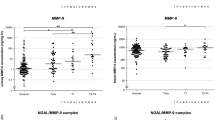Abstract
Purpose
Recently, a proteomic study of sera from patients with bladder cancer identified S100A8 and S100A9 as tumor-associated proteins. The present cross-sectional study investigates whether calprotectin, the heterodimer of S100A8/S100A9 may serve as a urinary biomarker for the detection of urothelial bladder cancer.
Methods
Urinary calprotectin concentrations were assessed in a population of 181 subjects including 46 cases of bladder cancer. 41 cases of renal cell cancer, 54 cases of prostate cancer, and 40 healthy subjects served as control. Acute kidney injury, urinary tract infection, previous BCG-treatment and secondary transurethral resection of the bladder tumor were defined as exclusion criteria. Assessment was performed by enzyme-linked immunosorbent assay and immunohistochemistry detecting calprotectin.
Results
Median calprotectin concentrations (ng/ml) were significantly higher in patients with bladder cancer than in healthy controls (522.3 vs. 51.0, p < 0.001), renal cell cancer (90.4, p < 0.001), and prostate cancer (71.8, p < 0.001). In urothelial carcinoma prominent immunostaining occurred in a subset of tumor cells and in infiltrating myeloid cells. Receiver operating characteristic analysis provided an area under the curve of 0.88 for the differentiation of bladder cancer and healthy control. A cut-off value of 140 ng/ml (determined by Youden’s index) resulted in sensitivity and specificity values of 80.4 and 92.5 %. Low grade tumors were associated with significantly lower calprotectin concentrations than high grade tumors (351.9 vs. 1635.2 ng/ml, p = 0.004).
Conclusions
Urothelial malignancies are associated with highly increased concentrations of calprotecin in the urine. In absence of renal failure and pyuria, calprotectin constitutes a promising biomarker for the detection of bladder cancer.




Similar content being viewed by others
References
Ploeg M, Aben KKH, Kiemeney LA (2009) The present and future burden of urinary bladder cancer in the world. World J Urol 27:289–293. doi:10.1007/s00345-009-0383-3
Lotan Y, Roehrborn CG (2003) Sensitivity and specificity of commonly available bladder tumor markers versus cytology: results of a comprehensive literature review and meta-analyses. Urology 61:109–118; discussion 118
Yafi FA, Brimo F, Auger M, Aprikian A, Tanguay S, Kassouf W (2013) Is the performance of urinary cytology as high as reported historically? A contemporary analysis in the detection and surveillance of bladder cancer. Urol Oncol. doi:10.1016/j.urolonc.2012.09.011
Mitra AP, Cote RJ (2010) Molecular screening for bladder cancer: progress and potential. Nat Rev Urol 7:11–20. doi:10.1038/nrurol.2009.236
Tilki D, Burger M, Dalbagni G, Grossman HB, Hakenberg OW, Palou J, Reich O, Rouprêt M, Shariat SF, Zlotta AR (2011) Urine markers for detection and surveillance of non-muscle-invasive bladder cancer. Eur Urol 60:484–492. doi:10.1016/j.eururo.2011.05.053
Minami S, Sato Y, Matsumoto T, Kageyama T, Kawashima Y, Yoshio K, Ishii J-I, Matsumoto K, Nagashio R, Okayasu I (2010) Proteomic study of sera from patients with bladder cancer: usefulness of S100A8 and S100A9 proteins. Cancer Genomics Proteomics 7:181–189
Kim S-K, Kim E-J, Leem S-H, Ha Y-S, Kim Y-J, Kim W-J (2010) Identification of S100A8-correlated genes for prediction of disease progression in non-muscle invasive bladder cancer. BMC Cancer 10:21. doi:10.1186/1471-2407-10-21
Seibert FS, Pagonas N, Arndt R, Heller F, Dragun D, Persson P, Schmidt-Ott K, Zidek W, Westhoff TH (2013) Calprotectin and neutrophil gelatinase-associated lipocalin in the differentiation of pre-renal and intrinsic acute kidney injury. Acta Physiol Oxf Engl 207:700–708. doi:10.1111/apha.12064
Heller F, Frischmann S, Grünbaum M, Zidek W, Westhoff TH (2011) Urinary calprotectin and the distinction between prerenal and intrinsic acute kidney injury. Clin J Am Soc Nephrol (CJASN) 6:2347–2355. doi:10.2215/CJN.02490311
Rosenberger C, Mandriota S, Jürgensen JS, Wiesener MS, Hörstrup JH, Frei U, Ratcliffe PJ, Maxwell PH, Bachmann S, Eckardt K-U (2002) Expression of hypoxia-inducible factor-1alpha and -2alpha in hypoxic and ischemic rat kidneys. J Am Soc Nephrol (JASN) 13:1721–1732
Ehrchen JM, Sunderkötter C, Foell D, Vogl T, Roth J (2009) The endogenous Toll-like receptor 4 agonist S100A8/S100A9 (calprotectin) as innate amplifier of infection, autoimmunity, and cancer. J Leukoc Biol 86:557–566. doi:10.1189/jlb.1008647
Gebhardt C, Németh J, Angel P, Hess J (2006) S100A8 and S100A9 in inflammation and cancer. Biochem Pharmacol 72:1622–1631. doi:10.1016/j.bcp.2006.05.017
Gebhardt C, Breitenbach U, Tuckermann JP, Dittrich BT, Richter KH, Angel P (2002) Calgranulins S100A8 and S100A9 are negatively regulated by glucocorticoids in a c-Fos-dependent manner and overexpressed throughout skin carcinogenesis. Oncogene 21:4266–4276. doi:10.1038/sj.onc.1205521
Grebhardt S, Veltkamp C, Ströbel P, Mayer D (2012) Hypoxia and HIF-1 increase S100A8 and S100A9 expression in prostate cancer. Int J Cancer J Int Cancer 131:2785–2794. doi:10.1002/ijc.27591
Hemmerlein B, Markus A, Wehner M, Kugler A, Zschunke F, Radzum HJ (2000) Expression of acute and late-stage inflammatory antigens, c-fms, CSF-1, and human monocytic serine esterase 1, in tumor-associated macrophages of renal cell carcinomas. Cancer Immunol Immunother CII 49:485–492
Pilchowski R, Stöhr R, von Eggeling F, Hartmann A, Wunderlich H, Junker K (2011) Specific protein patterns characterize metastatic potential of advanced bladder cancer. J Urol 186:713–720. doi:10.1016/j.juro.2011.03.124
Ortega FJ, Sabater M, Moreno-Navarrete JM, Pueyo N, Botas P, Delgado E, Ricart W, Frühbeck G, Fernández-Real JM (2012) Serum and urinary concentrations of calprotectin as markers of insulin resistance and type 2 diabetes. Eur J Endocrinol Eur Fed Endocr Soc 167:569–578. doi:10.1530/EJE-12-0374
Acknowledgments
We thank Simone Voigt and Silvia Heinze for their indefatigable efforts in this study. The study was funded by the German Research Foundation (Research Unit FOR1368).
Conflict of interest
None.
Author information
Authors and Affiliations
Corresponding author
Rights and permissions
About this article
Cite this article
Ebbing, J., Mathia, S., Seibert, F.S. et al. Urinary calprotectin: a new diagnostic marker in urothelial carcinoma of the bladder. World J Urol 32, 1485–1492 (2014). https://doi.org/10.1007/s00345-013-1227-8
Received:
Accepted:
Published:
Issue Date:
DOI: https://doi.org/10.1007/s00345-013-1227-8




